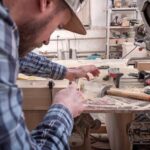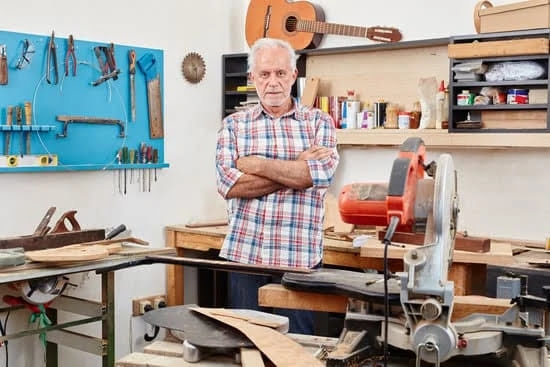Woodworking requires precision and attention to detail, especially when it comes to ensuring that pieces are square attached. The squareness of woodworking pieces is crucial for the overall quality and stability of a project. In this article, we will explore the importance of squareness in woodworking and provide an overview of the steps involved in making sure woodworking pieces are properly aligned.
Understanding what it means for woodworking pieces to be square is essential, as it directly impacts the structural integrity of a project. We will delve into the definition of squareness in woodworking and why it is vital for achieving high-quality results. Additionally, we will discuss the tools needed to ensure squareness, such as combination squares, framing squares, and speed squares, along with tips for selecting reliable tools.
Checking for squareness is an important step in any woodworking project, and we will provide a detailed guide on using a combination square to achieve this. Furthermore, we will explore other methods for checking squareness, such as the 3-4-5 triangle method and the diagonal measurement method. Additionally, we will cover techniques for making adjustments to woodworking pieces to ensure they are perfectly square while also highlighting common mistakes to avoid during this process.
Understanding Squareness in Woodworking
It is important for woodworking pieces to be square when attached in order to ensure the quality and stability of the final project. Squareness refers to the 90-degree angle that is formed when two pieces come together, and it is crucial for achieving precise and professional results in woodworking. Whether it’s building furniture, installing cabinets, or constructing a deck, ensuring that woodworking pieces are square attached is essential for the overall structural integrity of the project.
Achieving squareness in woodworking involves selecting the right tools and using proper techniques to check, adjust, and maintain squareness throughout the construction process. The use of tools such as a combination square, framing square, and speed square is necessary for accurately measuring and marking 90-degree angles. High-quality and reliable tools are essential for ensuring accuracy in woodworking projects, so it’s important to invest in tools that will stand the test of time.
Understanding squareness in woodworking also means recognizing the significance of precision in every aspect of the construction process. From making initial measurements to adjusting pieces as needed, attention to detail is key to achieving perfect squareness. Even small errors can compound throughout the project, leading to significant issues with stability and functionality. Therefore, woodworkers must prioritize precision at every step in order to make sure their woodworking pieces are square attached.
Selecting the Right Tools for Ensuring Squareness
Woodworking requires precision and attention to detail, especially when it comes to ensuring that pieces are square attached. This section will focus on the essential tools needed to achieve squareness in woodworking projects. Selecting the right tools is crucial for accurately measuring and adjusting woodworking pieces to ensure that they are perfectly square.
One of the most important tools for ensuring squareness in woodworking is a combination square. This versatile tool allows woodworkers to measure both 90-degree and 45-degree angles with ease. It consists of a ruler and a head that can be adjusted and locked into place, making it ideal for checking the squareness of joints, corners, and edges.
In addition to a combination square, a framing square is also an essential tool for ensuring squareness in larger woodworking projects. The framing square is designed specifically for marking and checking right angles, making it indispensable for tasks such as constructing cabinets, doors, and furniture. Finally, a speed square is another valuable tool that simplifies the process of measuring and marking angles quickly and accurately.
These three tools are instrumental in achieving precise squareness in woodworking projects. When selecting these tools, it’s important to prioritize quality and accuracy to ensure reliable results.
| Tool | Use |
|---|---|
| Combination Square | Measuring 90-degree and 45-degree angles |
| Framing Square | Marking and checking right angles |
| Speed Square | Measuring and marking angles quickly |
Methods for Checking Squareness
When it comes to woodworking, ensuring that the pieces are square attached is crucial for the overall quality and stability of the project. Understanding what it means for woodworking pieces to be square is the first step in achieving this.
Squareness refers to the 90-degree angle between two surfaces, which is essential for creating strong and properly fitting joints in woodworking projects. Without proper squareness, pieces may not align correctly, compromising the overall structure and aesthetics of the final product.
One of the key aspects of achieving squareness in woodworking is selecting the right tools for the job. Essential tools for ensuring squareness include a combination square, framing square, and a speed square. These tools allow woodworkers to accurately measure and confirm that their pieces are perfectly squared before proceeding with assembly. When choosing these tools, it’s important to prioritize quality and reliability to ensure accurate results.
In addition to using the right tools, woodworkers can employ different methods for checking squareness in their projects. One common method involves using a combination square to verify if edges and corners are at perfect right angles.
Additionally, alternative methods such as the 3-4-5 triangle method and diagonal measurement method can also be used to double-check the squareness of woodworking pieces. By understanding and utilizing these methods effectively, woodworkers can ensure that their projects are consistently squared throughout the construction process.
Adjusting Woodworking Pieces to Achieve Squareness
When working on woodworking projects, it is crucial to ensure that all pieces are square to achieve a high-quality and stable outcome. If the pieces are not properly squared, it can result in a finished product that is misaligned, unstable, or unsightly. To avoid these issues, woodworkers must understand how to make sure woodworking pieces are square attached. This involves not only selecting the right tools and checking for squareness but also making necessary adjustments throughout the woodworking process.
To achieve squareness in woodworking, it is essential to have the right tools at your disposal. Some of the essential tools for ensuring squareness include a combination square, framing square, and speed square. Additionally, having reliable measuring instruments such as a precision ruler and calipers can also aid in achieving accurate squareness in woodworking projects. When selecting these tools, it is important to choose high-quality options that provide precision and durability.
Once the tools are in place, woodworkers need to know how to use them effectively to check for and adjust squareness as needed. One method for checking squareness involves using a combination square. This versatile tool allows woodworkers to measure and mark 90-degree angles accurately.
The 3-4-5 triangle method is another effective way to check for squareness by measuring three units along one side of a piece, four units along the adjacent side, and five units across the diagonal between the two points. Lastly, the diagonal measurement method involves measuring from corner to corner diagonally on large sections of workpieces.
In addition to checking for squareness, woodworkers must be adept at making adjustments when necessary to ensure that pieces are perfectly squared. This involves techniques such as trimming edges with a handsaw or power saw, planing down uneven surfaces, or adjusting joinery methods if necessary.
It’s important to proceed with caution when making adjustments and avoid common mistakes such as over-trimming or altering measurements too drastically. By understanding how to select and use appropriate tools while employing effective adjustment techniques, woodworkers can maintain optimal squareness throughout their projects.
- Use clamps or bar clamps
- Check diagonals
- Measure opposite sides
- Use jointer or hand plane
Tips for Maintaining Squareness Throughout the Woodworking Process
Achieving squareness in woodworking is not just a one-time task; it requires consistent effort throughout the entire process of working on a project. Ensuring that woodworking pieces remain square attached from start to finish is essential for the overall quality and stability of the finished product.
Consistently Checking for Squareness During Assembly
One of the most important tips for maintaining squareness throughout the woodworking process is to consistently check for squareness during assembly. This involves using tools such as a combination square, framing square, or speed square at various stages of the project to verify that all components are aligned perfectly. By integrating these checks into the construction process, woodworkers can address any issues early on and make necessary adjustments to maintain squareness.
Preventing Squareness Issues as the Project Progresses
To ensure that woodworking pieces stay square attached as the project progresses, woodworkers should pay attention to factors such as moisture content, temperature changes, and external forces acting on the materials. These can all contribute to warping or misalignment of components. Using proper clamping techniques, allowing sufficient time for glue-ups to set, and storing materials in controlled environments can help prevent squareness issues from arising during the construction phase.
Importance of Precision Throughout
Maintaining precise measurements and cuts is crucial for preserving squareness in woodworking projects. Woodworkers should consistently double-check their measurements before making cuts or joining pieces together to avoid errors that could compromise squareness. Additionally, using high-quality tools with accurate markings and calibrations can significantly contribute to maintaining precision and ensuring that all components are perfectly squared throughout the woodworking process.
By implementing these tips and practices, woodworkers can effectively maintain squareness throughout each stage of their projects, ultimately yielding high-quality, stable, and visually appealing finished products.
Importance of Precision in Woodworking
Precision is crucial in woodworking as it directly impacts the quality and integrity of the finished pieces. When woodworking pieces are not square attached, it can lead to structural instability, uneven joints, and overall poor aesthetics. Achieving squareness ensures that the project will stand the test of time and meet high standards of craftsmanship.
One way to ensure woodworking pieces are square attached is by using precise measurements and accurate tools. The process begins with understanding what it means for pieces to be square in woodworking. This involves making sure that all corners form right angles and that edges are straight and true. Tools such as a combination square, framing square, and speed square are essential for achieving this precision.
Once the tools have been selected, woodworkers must carefully check for squareness using methods like the 3-4-5 triangle method or diagonal measurement method. If any adjustments are needed, techniques such as trimming or planing can be employed to correct any deviations from exact right angles. By regularly checking for squareness throughout the woodworking process, woodworkers can maintain precision and avoid costly mistakes.
| Woodworking Precision | Importance |
|---|---|
| Achieving Squareness | Ensures structural stability |
| Selecting Tools | Accurate tools essential for precision |
| Checking Methods | 3-4-5 triangle method and diagonal measurements |
| Maintaining Precision | Vigilance throughout woodworking process crucial |
Conclusion
Achieving precision and squareness in woodworking is crucial for the overall quality and stability of any project. Ensuring that woodworking pieces are square attached not only enhances the visual appeal of the finished product but also guarantees its structural integrity.
Throughout this article, we have discussed various aspects of achieving squareness in woodworking, from understanding what it means to be square to selecting the right tools and methods for checking and adjusting pieces. Now, let’s recap some key points and tips for ensuring that your woodworking pieces are square attached.
Consistent Checking and Adjustment
One of the most important aspects of maintaining squareness in woodworking is to consistently check for accuracy throughout the entire process. This involves using reliable tools such as a combination square or framing square to verify that angles are precise before joining pieces together. Additionally, making necessary adjustments promptly will help prevent issues with squareness from escalating as the project progresses.
Precision and Patience
Woodworking is a craft that demands patience and attention to detail. When striving for squareness in your projects, remember that precision is key. Taking the time to measure, mark, and adjust with care will ultimately result in well-crafted pieces that fit together seamlessly. Rushing through this process can lead to errors that compromise the overall squareness of your project.
Continuous Learning
Finally, never underestimate the value of continual learning when it comes to achieving squareness in woodworking. Whether you are a beginner or an experienced woodworker, there is always something new to learn about improving your techniques for ensuring accurate angles and joints. Exploring additional resources such as books, websites, and instructional videos can provide valuable insights into enhancing your skills and mastering the art of creating perfectly squared woodworking pieces.
By paying close attention to these principles – consistent checking and adjustment, precision and patience, as well as continuous learning – you can be confident that your woodworking pieces are always securely attached at perfect right angles.
Additional Resources and References
In conclusion, achieving squareness in woodworking is crucial for the quality and stability of any project. Ensuring that woodworking pieces are square attached is essential for creating well-built, aesthetically pleasing, and durable pieces. By following the steps outlined in this article and using the right tools, woodworkers can achieve the precision and accuracy necessary for squareness.
Selecting the right tools, such as a combination square, framing square, or speed square, is essential for ensuring that woodworking pieces are square attached. High-quality and reliable tools play a significant role in achieving precise measurements and angles. Additionally, understanding the methods for checking squareness, as well as techniques for making adjustments when necessary, will contribute to successful woodworking projects.
It is important to consistently check for squareness throughout the woodworking process to avoid potential issues. This includes paying attention to details during assembly and taking preventative measures to maintain squareness as the project progresses.
By doing so, woodworkers can ensure that their finished pieces are not only visually appealing but also structurally sound. Overall, maintaining precision and achieving perfect squareness in woodworking projects may require extra time and effort but ultimately leads to superior results that stand the test of time.
Frequently Asked Questions
How Do I Make Sure My Wood Joints Are Square?
To ensure that your wood joints are square, you can use a combination square to check the corners for 90-degree angles. Another method is to measure diagonally from corner to corner and compare the measurements. If the measurements are equal, then your joint is square.
How Do I Make Sure My Wood Frame Is Square?
When making a wood frame, it’s important to check for squareness by measuring diagonally from corner to corner and ensuring that the measurements are equal. You can also use clamps or corner brackets to hold the frame in place while checking for squareness.
How Do I Make Sure Something Is Square?
There are several methods to ensure that something is square. One common way is using a carpenter’s square or a combination square to check for 90-degree angles at corners.
Additionally, measuring diagonally across two opposite corners and comparing the measurements can help determine if something is square or not. Taking your time and being meticulous with measurements and angles will ensure that your project ends up perfectly square.

Hi everyone! I’m a woodworker and blogger, and this is my woodworking blog. In my blog, I share tips and tricks for woodworkers of all skill levels, as well as project ideas that you can try yourself.





